Decades of committed research has demystified the concept of human nutrition and the series of processes which the chunks of semi-solid foods we consume and the liquids we take get to be utilized by the body to bring about the comfort we feel after taking them in a process known as metabolism.
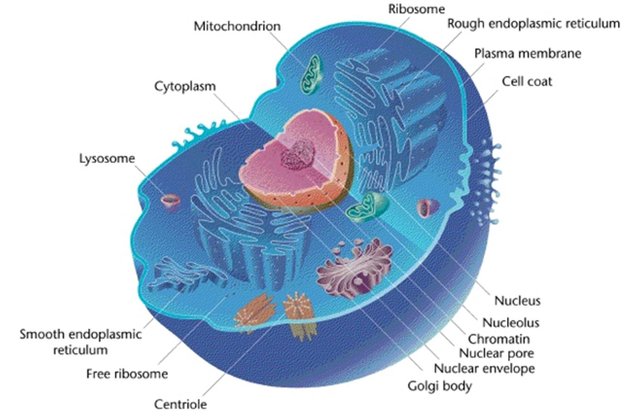
Eukaryotic animal cell. Source:wikimedia - CC BY-SA 3.0.
For life to be sustained, these actions of a cell must also be maintained, growth of an individual depends on the sexual reproduction and asexual replication of individuals cells which accounts for the evenness in growth and in the cell counts, sensitivity via molecular signals which are translated on a cellular level enable the cells to respond to stimuli through certain organelles which aids their locomotion. Hence some cells such as amoeba which can perform these actions sufficiently are found living freely in the ecosystem, away from combination and interaction with any other cells and in a little bit higher level, Hydra exist freely as a tissue.
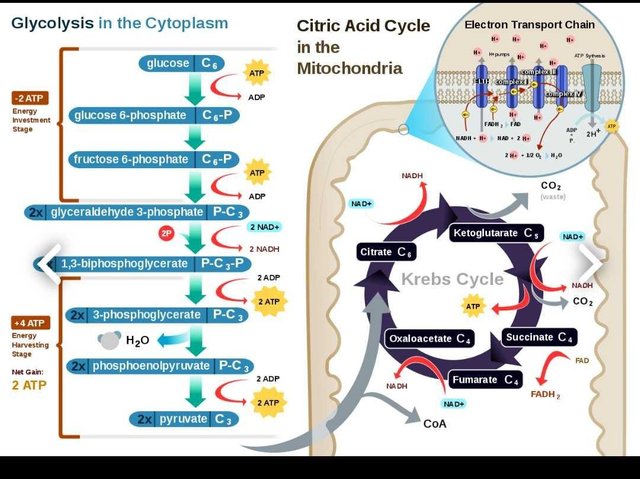
Scheme of cellular respiration . Source:Wikimedia - CC BY-SA 3.0.
Free living cells require very little energy relative to cells which combines in the formation of tissues, organs or cells which makes up the systems in a systemic organism such as mammals. Amoebas can survive with a minimal supply of nutrients due to little energy requirement, but the amount of energy required increases with complexity. As we move from cellular to tissue to organic and to systemic level of complexity, the energy requirement also increases and systemic organisms thus requires a large amount of energy to sustain their actions which are far more energy tasking than that seen in cells.
Nutrition and every action that accompanies this process becomes a very important aspect of the everyday life of higher organisms, unlike smaller organisms which could survive for a very long while without tangible nutrition, systemic organisms such as humans requires a constant and quality supply of nutrition, and the body’s mechanism and procedures of breaking down these ingested substances are also sophisticated enough to meet this high load.

Source:Wikimedia - CC BY-SA 3.0.
The end point of this process is the conversion of these nutrients in to minerals in the forms of ions and smaller molecules such as ammonia (NH3+), carbondioxide and water, free fatty acids and cholesterol and other smaller molecules which the body cells can actually make use of. These smaller molecules can diffuse comfortably across the cell membranes to ensure cell sustenance. However, due to high energy demand, there arises the need to provide a reliable store of energy which can be easily processed by the body system in case of emergency energy demand which may be seen in starvation. When well fed, the body cells stores food in form of high energy molecules such as Adenosine Triphosphate (ATP)–the energy currency of the cell.
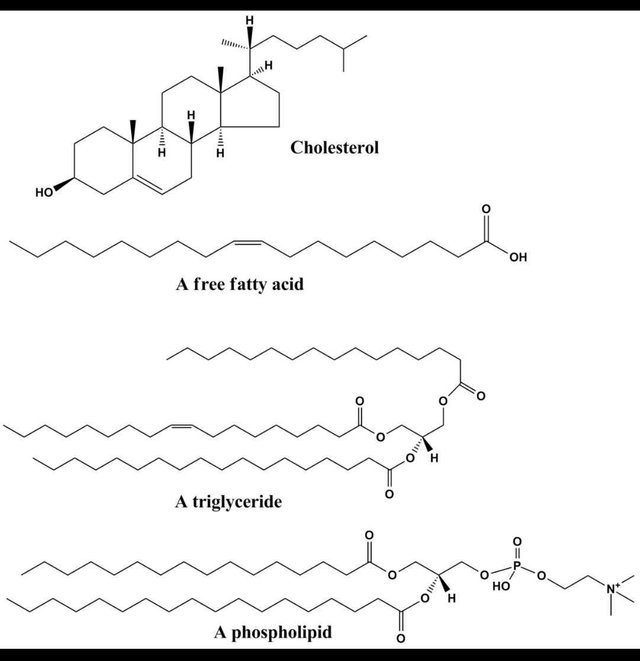
lipids. Source:Wikimedia - CC BY-SA 3.0.
Energy is also stored in form of larger molecules which is usually lipids. Energy from other class of food is stored in the form of lipids by conversion into glycerol, and stored under the skin as adipose tissues, in starved state, fatty acids play a central role in providing energy to the tissues particularly during fasting, it provides energy to the liver, kidneys, skeletal muscle and myocardium, but not the brain as fatty acids cannot cross the blood-brain barrier, but the brain makes use of these lipids when they are converted to ketone bodies which supplies about 70% of the brain’s energy demand during starvation.
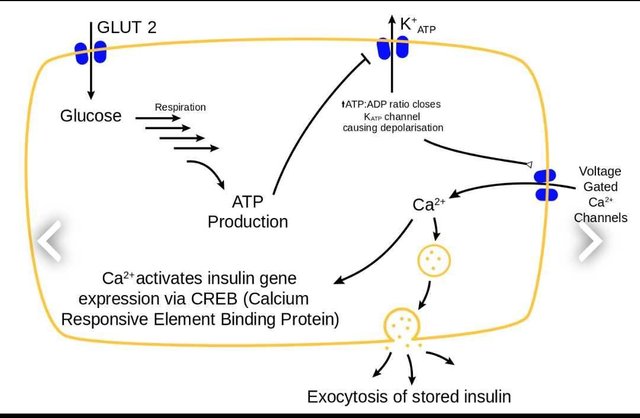
Insulin release from Beta-cells of pancreatic islets. Source:Wikimedia - CC BY-SA 3.0.
In fed state, the excess glucose from the carbohydrates enters the Beta-cells of the pancrease and stimulates the production of ATP and ADP, this causes a depolarization of the Beta-cells and a subsequent influx of calcium ion (Ca2+) which triggers the release of insulin– a 51(fifty-one) amino acids polypeptide hormone through exocytosis, insulin hastens the transport of glucose into the cells via the Glucose transport channel 4 (GLUT4) to prevent it’s accumulation in the blood which is the sole cause of hyperglycemia.
Inside the cells, the transported glucose is converted to lipid which is less toxic form through the conversion of Dihydroxyacetone phosphate (DHAP) – an intermediate of carbohydrates breakdown through the glycolytic pathway to Triacyl glyceride. Dihydroxyacetone phosphate is first reduced to gycerol-3-phosphate by enzyme glycerol-3-posphate dehydrogenase an oxidoreductase by transferring a hydrogen ion from NADH (reduced Nicotinamide Adenine Dinucleotide) to DHAP.
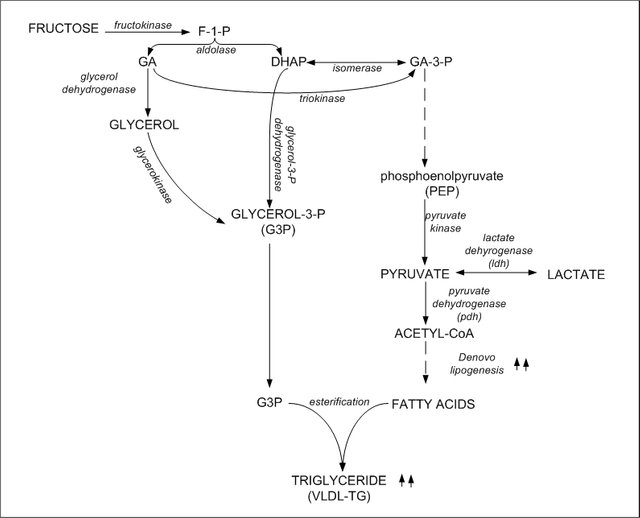
DHAP to Triglyceride conversion. Source:Wikimedia - CC BY-SA 3.0.
Through hydrolysis and esterification with fatty acids, glycerol-3-phosphate is used to synthesize Triacyl glyceride (TAG). Triacyl glyceride is the storage form of lipids in the body and hence glycerol-3-phosphate dehydrogenase enzyme serves as a link between carbohydrates and lipid metabolism, excess glucose from the food we take is converted to lipid and stored through this pathway.
But then things went wrong…
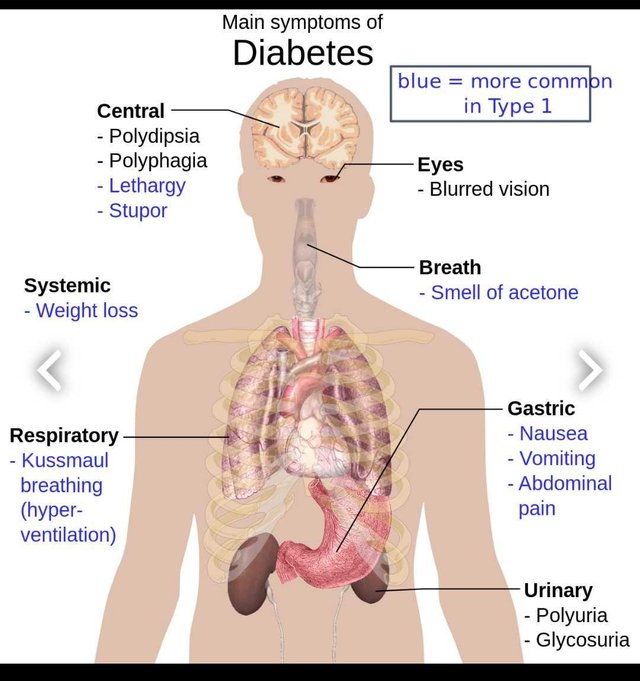
symptoms of diabetes . Source:Wikimedia - CC BY-SA 3.0.
Continued synthesis of glycerol-3-phosphate from excess glucose leads to the accumulation of glycerol-3-phosphate, excess production of lipids from the conversion of glycerol-3-phosphate to Triacyl glyceride accounts for the obesity seen in type 2 diabetes mellitus (Non-insulin dependent diabetes mellitus), free fatty acids released from Triacyl glyceride by the actions of lipoprotein lipase and hepatic lipase are elevated in the blood of subjects with central obesity, insulin resistance and type 2 diabetes. Diabetes mellitus is a group of disorder of carbohydrate metabolism in which glucose is underutilized leading to a high level of glucose in the blood (hyperglycemia).
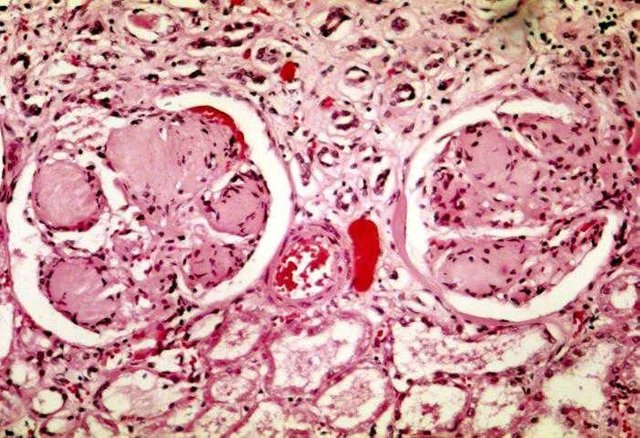
Two glomeruli in diabetic nephropathy . Source:Wikimedia - CC BY-SA 3.0.
Type 2 diabetes mellitus subjects are noticeably obese due to accumulation of fat under the skin, insulin resistance and Beta-cells dysfunction have been implicated in most cases, though many findings also indicates a normal insulin secretion in type 2 diabetes mellitus, associated defects in the renal , nervous and optic systems in form of diabetic nephropathy, neuropathy and retinopathy respectively has made this condition a very dreadful pathologic state, secondary infections due to these defects includes blindness, gangrene feet, renal failure and kussmaul breathing due to over accumulation of Ketone bodies from excess fatty acid breakdown makes this condition very hard to manage. Glycerol-3-phosphate, an intermediate of glucose—lipid conversion is well pronounced in these damages in tissues, organs and Beta-cells of the pancrease.
This has led to the popular slogan ‘sugar is poison’, when seen from this angle though, sugar is really poisonous as regards the perils one has to go through in managing cases resulting from excess consumption of sugar, many sugar lovers find this very disturbing, while many who takes little sugar are only doing this as they are scared of the defects associated with sugar overload, of which diabetes mellitus is the major issue. Personally it pains me that I’d be unable to take as much chocolates and soft drinks as I wish, traumatizing in deed. Maybe there could be a way, just maybe…
Sodium Tungstate: Where do we go from here?
An abstract from sciencedirect reads thus:
Tungstate counteracts diabetes and obesity in animal models, but its molecular mechanisms remain elusive. Our Saccharomyces cerevisiae-based approach has found that tungstate alleviated the growth defect induced by nutrient stress and enhanced the activation of the GCN pathway. Tungstate relieved the sensitivity to starvation of a gcn2-507 yeast hypomorphic mutant, indicating that tungstate modulated the GCN pathway downstream of Gcn2p. Interestingly, tungstate inhibited Glc7p and PP1 phosphatase activity, both negative regulators of the GCN pathway in yeast and humans, respectively. Accordingly, overexpression of a dominant-negative Glc7p mutant in yeast mimicked tungstate effects. Therefore tungstate alleviates nutrient stress in yeast by in vivo inhibition of Glc7p. These data uncover a potential role for tungstate in the treatment of PP1 and GCN related diseases.
Researches on possible anti-diabetic compounds have continued over the years and this has led to a better understanding of the mechanism of action of diabetes mellitus.
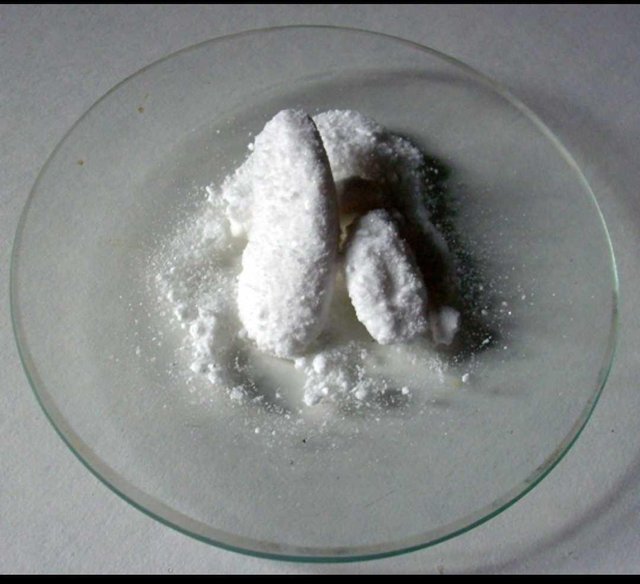
sodium tungstate . Source:Wikimedia - CC BY-SA 3.0.
The correct mechanism of tungstate action is yet to be unravelled, however, evidences shows that tungstate inhibits the growth defects induced by nutrient stress and enhances the General Control of Nutrient (GCN) pathway, defects in GCN pathway has been shown to cause most disorders of metabolism. Mutation of GCN2p protein kinase orthologue in mammals — the Protein Kinase R-like Endoplasmic Reticulum Kinase (PERK) has been implicated as the major cause of wolcott-Rallison syndrome, a rare diabetic disorder seen in children; mice which lacks this enzyme develops hyperglycemia and B-cell death, hence, activation of the GCN pathway may alleviate this condition.
Glycerol-3-phosphate phosphatase: A permanent answer in view?
Sodium tungstate and tungstate therapy have proven efficient in diabetes therapy in experiments with lower mammals, mammals are closely connected in evolution and this is due to significant similarities in their biology and physiology, this livens the hope of treatment with tungstate being effective in humans too, unfortunately, experiments with humans are more tedious and sensitive due to human right infringement and civilization issues, hence a very big limitation in experiments with humans. This has dampened the development of a human-effective tungstate anti-diabetic therapy. While this continues, the hope of a permanent cure and prophylactic compound have been dampened… but there’s a dim light around the corner…
Researchers at the University of Montreal Teaching Hospital had announced the re-discovery of a previously unidentified enzyme with anti-diabetic effect. Glycerol-3-phosphate phosphatase .Taming the effect of Glycerol-3-phosphate which have already been shown to cause most harms associated with type 2 diabetes mellitus and synthesized in the body by the reduction of Dihydroxyacetone phosphate and also by the phosphorylation of glycerol by glycerokinase proved therapeutic experimentally, a reduced production of glycerol-3-phosphate would highly decrease the pathologic conditions associated with diabetes.
Glycerol-3-phosphate phosphatase is a 321 amino acids containing enzyme whose synthesis is encoded by the glycerol-3-phosphate phosphatase / phospho-glycero-phosphatase (PGP) gene located on the short arm of chromosome 16 in the humans and chromosomes 10 and 17 in rats and mice respectively. Glycerol-3-phosphate phosphatase belongs to the enzyme super family of haloacid dehalogenase–like hydrolases which is predominated by phosphatase (about 79%) and ATpases. It is found to act on several substrates such as glycolytic side products, nucleotides, glycerol-3-phosphate and phosphotyrosine with varying degrees of activity.
This enzyme have been discovered to have a key function of glycerol-3-phosphate hydrolysis in mammalian cells and also acts as a metabolic repair enzyme by eliminating toxic side products from pentose phosphate pathway and glycolytic pathways, it has also shown to play a role in the uterine development of embryo as a deletion of this gene in experimental mice results in embryonic lethality.
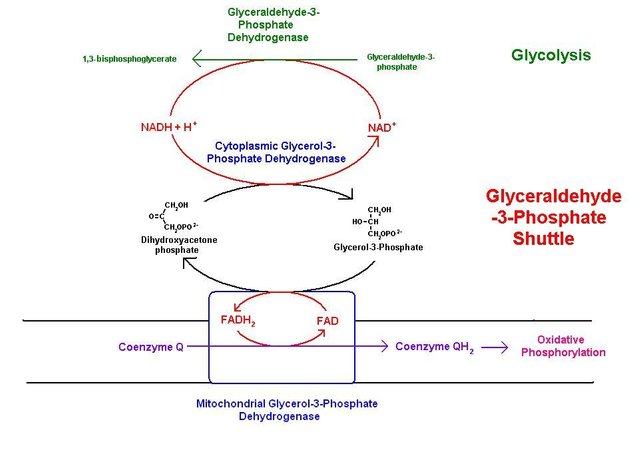
Removal of the phosphate group from G3P disrupts the glycerol-3-phosphate cycle as glycerol is moved out of the cell, hence less triglycerides is produced . Source:wikimedia - CC BY-SA 3.0.
In conclusion…
The struggle continues however as the development of a glycerol-3-phosphate phosphatase therapy also meets a similar fate as Tungstate, the experiment with laboratory animals have been convincing, but performing these experiments with humans would require several processes and would cost more, the time and cost intensive nature of this experiment has greatly limited the speed of development of this experiment and it’s would take years to decades before the production of a reliable glycerol-3-phosphate phosphatase or tungstate therapy will be achieved.
Unfortunately we bounce back to the same position, presently it is only advisable to stick to the normal low-sugar dietary schedule and diabetic individuals should also ensure proper adherence to the specific management procedures and only hope that the success of these researches gets faster and the permanent answer comes quicker.
Thanks for reading…
References
6.The Anti-diabetic Effects Of Sodium Tungstate Revealed~sciencedaily
If you write STEM (Science, Technology, Engineering, and Mathematics) related posts, consider joining #steemSTEM on steemit chat or discord here. If you are from Nigeria, you may want to include the #stemng tag in your post. You can visit this blog by @stemng for more details. You can also check this blog post by @steemstem here and this guidelines here for help on how to be a member of @steemstem. Please also check this blog post from @steemstem on proper use of images devoid of copyright issues here.

Does this diabetes guy have any relationship with cancer?
Downvoting a post can decrease pending rewards and make it less visible. Common reasons:
Submit
Of course, cancer cells depends largely on lipolysis instead of glycolysis, hence increased lipolysis in diabetes supports the development of cancer cells, this is where the two pathologies intersect.
Thanks for reading through.
Downvoting a post can decrease pending rewards and make it less visible. Common reasons:
Submit
Though the words are getting bigger but thanks
Downvoting a post can decrease pending rewards and make it less visible. Common reasons:
Submit
Sorry for the big words, I just mean that cancer cells depends more on products of lipids breakdown such as ketone bodies and free fatty acids instead of products of carbohydrate breakdown such as α-ketoglutarate. So in diabetes, lipid metabolism is more pronounced, so cancer cells will develop more in this state of health. That's where the two conditions are related. That's just what I mean.
Downvoting a post can decrease pending rewards and make it less visible. Common reasons:
Submit
Hello @joelagbo,
Air-Clinic sends her greeting!
We are happy that you are creating amazing medical contents on Steemit using the #Air-Clinic tag.
This article was found as a result of #Air-Curie Initiative!We encourage you to keep it up!
Expect an upvote from @Air-Clinic soon!
If you haven't joined us on Discord please do so by clicking here
Cheers!
@drqbm- Air-Clinic Curator!
Downvoting a post can decrease pending rewards and make it less visible. Common reasons:
Submit
This post has been voted on by the steemstem curation team and voting trail.
There is more to SteemSTEM than just writing posts, check here for some more tips on being a community member. You can also join our discord here to get to know the rest of the community!
Downvoting a post can decrease pending rewards and make it less visible. Common reasons:
Submit
Hi @joelagbo!
Your post was upvoted by utopian.io in cooperation with steemstem - supporting knowledge, innovation and technological advancement on the Steem Blockchain.
Contribute to Open Source with utopian.io
Learn how to contribute on our website and join the new open source economy.
Want to chat? Join the Utopian Community on Discord https://discord.gg/h52nFrV
Downvoting a post can decrease pending rewards and make it less visible. Common reasons:
Submit